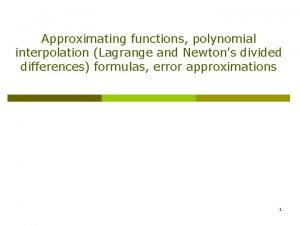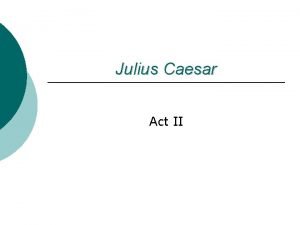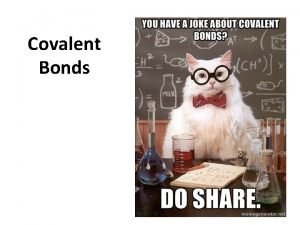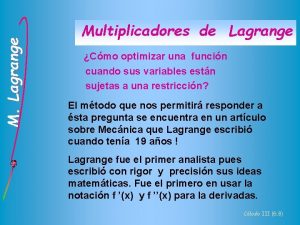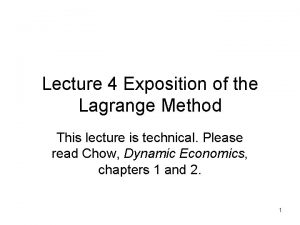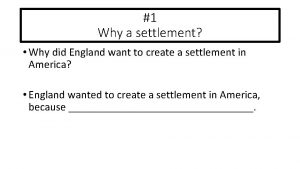Lagrange Method Lagrange Method Why do we want






















- Slides: 22

Lagrange Method

Lagrange Method • Why do we want the axioms 1 – 7 of consumer theory? • Answer: We like an easy life! By that we mean that we want well behaved demand curves.

Let’s look at a Utility Function: U = U( , y) Take the total derivative: For example if MUx = 2 MUy = 3

Look at the special case of the total derivative along a given indifference curve: dy dx

y x • Taking the total derivative of a B. C. yields Px dx + Py dy = d. M • Along a given B. C. d. M = 0 Px dx + Py dy = 0

y Equilibrium x => Slope of the Indifference Curve = Slope of the Budget Constraint

We have a general method for finding a point of tangency between an Indifference Curve and the Budget Constraint: The Lagrange Method Widely used in Commerce, MBA’s and Economics.

y u 0 u 1 u 2 Idea: Maximising U(x, y) is like climbing happiness mountain. x y But we are restricted by how high we can go since must stay on BC (path on mountain). x

y u 0 u 1 u 2 So to move up happiness Mountain is subject to being on a budget constraint path. x Maximize U (x, y) subject to Pxx+ Pyy=M

=0 =0 =0 Known: Px, Py & M Unknowns: x, y, l 3 Equations: 3 Unknowns: Solve

Trick: Note: But: U

=0 =0 =0 Known: Px, Py & M Unknowns: x, y, l 3 Equations: 3 Unknowns: Solve



Notice: U = x 2 y 3 <=> Slope of the Indifference Curve Recall Slope of Budget Constraint = Slope of IC = slope of BC

Back to the Problem: + But +

Back to the Problem: + But +

So the Demand Curve for x when U=x 2 y 3 If M=100: Px x. D 10 4 8 5 5 8 2 20

Recall that: U = x 2 y 3 Let: U = xa yb For Cobb - Douglas Utility Function

Note that: Cobb-Douglas is a special result In general: For Cobb - Douglas:

Why does the demand for x not depend on py? Share of x in income = In this example: Constant Similarly share of y in income is constant: So if the share of x and y in income is constant => change in Px only effects demand for x in C. D.

Constraint Objective fn So l tells us the change in U as M rises Increase from U 1 to U 2 Increase M in objective fn in constraint
 Andreas carlsson bye bye bye
Andreas carlsson bye bye bye Don't ask why why why
Don't ask why why why Interpolation quadratic
Interpolation quadratic Lagrange
Lagrange Lagrange method
Lagrange method Cherry valance description
Cherry valance description The lightning thief chapter 12
The lightning thief chapter 12 What promise does brutus make to rome?
What promise does brutus make to rome? Why do you want to work for us
Why do you want to work for us Without whom would the windmill have been impossible
Without whom would the windmill have been impossible Sudantenland
Sudantenland Streetcar named desire scene 1
Streetcar named desire scene 1 Tsotsi literature essay on decency
Tsotsi literature essay on decency How do peeta and katniss gain haymitch's support?
How do peeta and katniss gain haymitch's support? Why did josette dugas want to go to war
Why did josette dugas want to go to war I want a wife satire
I want a wife satire Why does she want the wretched refuse of teaming shores?
Why does she want the wretched refuse of teaming shores? Covent bond
Covent bond Why did singapore want to merge with malaysia
Why did singapore want to merge with malaysia Of mice and men chapter 1 study questions
Of mice and men chapter 1 study questions Macbeth act 3, scene 2 translation
Macbeth act 3, scene 2 translation How was jack liberated from the shame of self-consciousness
How was jack liberated from the shame of self-consciousness Cold war jeopardy
Cold war jeopardy



